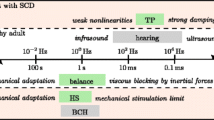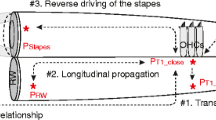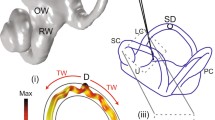Abstract
Inner ear pressure was measured in scala tympani with a micropipette during square wave pressure manipulation of the intracranial compartment and, subsequently, of the external ear canal (EEC) in the same guinea pig. As expected, the combination of the cochlear aqueduct and the inner ear behaves as a low-pass filtering system for intracranial pressure manipulation and as a complementary high-pass system for ear canal pressure manipulation. Time constants for pressure equalization were in the order of seconds and depended on the direction of flow through the cochlear aqueduct. Pressure equalization curves could not be fitted to a single exponential function; more complicated functions were needed for good fits, showing that the pressure equalization process is nonlinear. This means that the flow resistance of the cochlear aqueduct and/or the compliance of the cochlear windows is not constant, which is in accordance with a flow-direction dependent resistance of the cochlear aqueduct. An explanation for this can be found in the special structure of the periotic duct inside the aqueduct.
Similar content being viewed by others

Author information
Authors and Affiliations
Additional information
Received: 24 July 2001 / Accepted: 28 September 2001
Rights and permissions
About this article
Cite this article
Thalen, E., Wit, H., Segenhout, H. et al. Inner ear pressure changes following square wave intracranial or ear canal pressure manipulation in the same guinea pig. European Archives of Oto-Rhino-Laryngology 259, 174–179 (2002). https://doi.org/10.1007/s00405-001-0431-0
Issue Date:
DOI: https://doi.org/10.1007/s00405-001-0431-0



